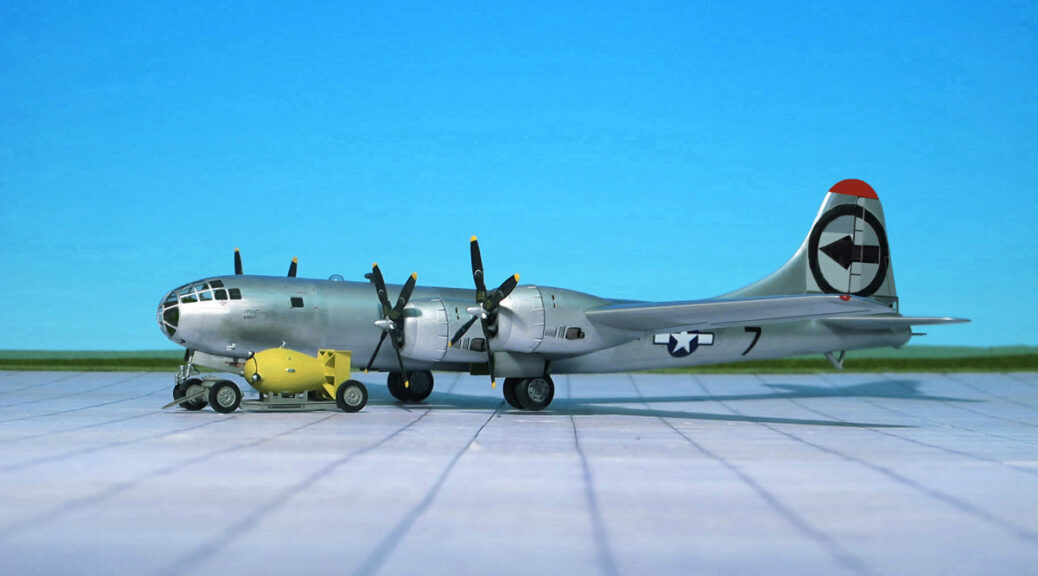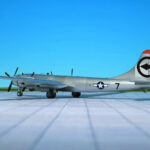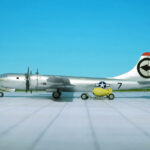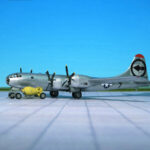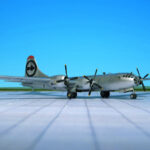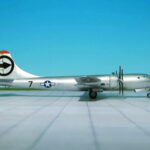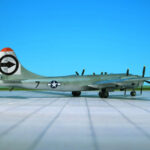BOEING B-29A SUPERFORTRESS ‚BOCKSCAR‘
Bockscar, sometimes called Bock’s Car, is the name of the United States Army Air Force (USAAF) B-29 bomber that dropped a Fat Man, a plutonium implosion-type nuclear weapon, over the Japanese city of Nagasaki during World War II in the second – and most recent – nuclear attack in history.
Bockscar, B-29-36-MO 44-27297, Victor number, (unit-assigned identification number) # 7, was built by the Glenn L. Martin Company at its bomber plant in Bellevue, Nebraska and one of 15 Silverplate B-29, a Block 35 aircraft, after modification re-designated “Block 36”. It was delivered to the United States Army Air Forces on 19 March 1945 and in April assigned to the 393rd Bombardment Squadron, 509th Composite Group to Wendover Army Air Field, Utah, and was named after Captain Frederick C. Bock.
Silverplate involved extensive modifications to the B-29 to carry nuclear weapons. The bomb bay doors and the fuselage section between the bomb bays were removed to create a single 33-foot bomb bay. British suspensions and bracing were attached for both shape types, with the gun-type (Little Boy) suspension anchored in the aft bomb bay and the implosion type (Fat Man) mounted in the forward bay. Weight reduction was also accomplished by removal of gun turrets and armor plating. These B-29s also had an improved engine, the Wright R-3350-41. The Silverplate aircraft represented a significant increase in performance over the standard variants.
Captain Frederick C. Bock and crew C-13, flew to Wendover Army Air Field in April. The name chosen for the aircraft, and and the nose art painted on it after the mission, was a pun on the name of the aircraft commander. It left Wendover on 11 June 1945 for Tinian, where it arrived 16 June. It was originally given a circle outline around an arrowhead pointing forward tail marking as used by the 509th Composite Group. Bockscar was used in 13 training and practice missions from Tinian, and three combat missions in which it dropped Pumpkin bombs on industrial targets in Japan, in which Bock’s crew bombed Niihama, Musashimo and Koromo.
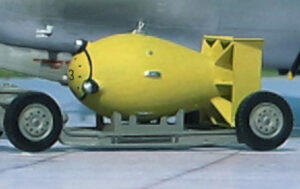
PUMPKIN BOMBS
„Pumpkin bombs“ were conventional aerial bombs developed by scientists of the Manhattan Project and used by the United States Army Air Forces against Japan during WW II. It was a close replication of the „Fat Man“ plutonium bomb with the same ballistic and handling characteristics, but it used non-nuclear conventional high explosives. It was mainly used for testing and training purposes, which included combat missions flown with pumpkin bombs by the 509th Composite Group. The name “pumpkin bomb” was the term used in official documents from the large, fat ellipsoidal shape of the munition casing instead of the more usual cylindrical shape of other bombs, intended to enclose the „Fat Man’s“ spherical “physics package” (the plutonium implosion nuclear weapon core).
„Pumpkin bombs“ were produced in both inert and high-explosive variants. The inert versions were filled with a cement-plaster-sand mixture that was combined with water to 1.67 to 1.68 grams per cubic centimetre, the density of the composition high-explosive versions. The filler of both variants had the same weight (2,900 kg) and weight distribution as the inner spherical “physics package” of the „Fat Man“ plutonium bomb.
A total of 486 live and inert training bombs were eventually delivered, the 509th Composite Group dropped a total of 49 bombs on 14 Japanese targets (Ref. 24).
